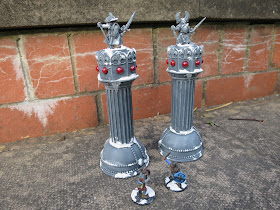Sharp Practice 2 arrived this week and I have just finished reading
it. I have yet to play the game but I am very excited about the new rules.
I had the old Sharp Practice but I always found the rules
were a bit disorganised and a little bit rough round the edges. Added to this
was the fact that my regular gaming opponent, Pulp Citizen, strongly dislikes games which don’t
have at least some sort of point based system to give a ‘fair’ game. I did like
the quirky character generation rules that imbued your leaders with
personalities and back stories, as this really helped to get the Bernard
Cornwall/ CS Foster feel for the game. But in the end we never really played
the old Sharp Practice, preferring to play smaller skirmishes with Songs of
Drums and Shakos.
Sharp Practice 2 is very different animal to its predecessor.
First impressions are that it is a slick produced, and good quality rule book: modern and full colour all the way through, as
you would expect. There are lots of nice colour photographs of figures too, although
no illustrations. The next thing which struck me after a casual flick through
the rules was how superficially similar it looked to Chain of Command
(obviously by the same writer/production team). This similarity continued to
strike me as I started reading the rules. Players familiar with Chain of Command
will be already familiar with many of the concepts in Sharp Practice 2- Deployment
Points, Random Movement, shock points etc. At first I wondered if Richard
Clarke had just adapted the winning formula from Chain of Command to the Napoleonic
period but the more I read the more I realised that this wasn’t CoC, but rather
something new. It borrows form CoC, then mashes them up with the old Sharp
Practice, and what comes out is a well written, well produced rules that it
very fit for purpose, and yet retains much of the character and narrative driven
of the original Sharp Practice rules.
The rules are written in a manner that suggest it is not to
be taken too seriously (I wonder how well this will go down with some of the notoriously
serious-minded Napoleonic gamers). For example close quarters battle is called ‘Fisticuffs’
and there are rules for some of your men deserting in search of loot of being
lured away by attractive milkmaids. The character generation rules from the original
rules have, thankfully, been retained, and even expanded on. I was glad to see they
kept the rules for caddish officers seducing ladies, as these were something of
a unique selling point in a wargame rules.
While the original Sharp Practice focused on the Napoleonic Wars,
Sharp Practice 2 expands the period to cover from 1700-1865. There are army lists
for the French and Indian Wars, the American War of Independence, The Peninsular
War, The American Civil War and The Indian Mutiny included in the core rules,
and Richard Clarke is promising to make many more army lists available on the Two
Fat Lardies website. I am particularly please with this as I have forces for
the French and the British for the Peninsular War, and I am building up forces
for the French and Indian Wars. I have also always wanted to wargame Clive of
India’s campaigns, and there is a good chance there rules would fit the bill
nicely. The army lists have a point based system, and a lot of flexibility in
how you build your forces, as well as the chance to take support options not normally
used in wargames, such as supply wagons and engineers
My overall impression is that this is a great game that brings
the original Sharp Practice rules up to date without compromising its charm and
narrative driven plotlines. This could be my new go-to rules for 18th
and 19th century wargaming.













































